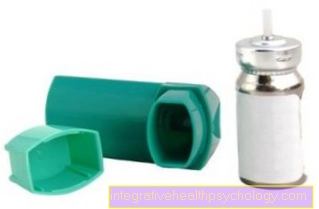Long-term consequences of a femoral neck fracture
introduction
Of the Femoral neck fracture (Syn .: Femoral neck fracture) is one of the common fractures in the elderly. A banal fall is sufficient as an accident mechanism in many cases. As a result of reduced Bone density at osteoporosis the risk of such injuries increases.
Of the Femoral neck represents the connection between the head of the femur and the shaft of the femur rapid stabilization the fracture and especially the rapid mobilization after the accident are of great importance. Possible after-effects, like one Femoral head necrosis, one Hip osteoarthritis or one Leg length difference, can be counteracted with the help of adequate, early therapy.

Femoral head necrosis
Femoral head necrosis is also known as post-traumatic femoral head necrosis and can occur as a late consequence of a femoral neck fracture. Reduced blood flow to the femoral head leads to the death of bone tissue. Necrosis of the femoral head can be caused by alcoholism and metabolic disorders. If the bone tissue is insufficiently supplied with oxygen over a longer period of time, it demineralizes and dies. The blood supply to the head of the femur and the femur neck is ensured by the circular circumflex artery. In about a fifth of the cases, the capitis femoris artery also supplies the femoral head. The vessels form numerous connections, so-called anastomoses, and in this way communicate with one another.
If several of the vascular connections are interrupted, the safe blood flow to the head of the femur is no longer guaranteed. Particularly in the case of fractures close to the femoral head with strong displacement of the fragments and when the femoral neck fracture is screwed together, there is an increased risk of developing femoral head necrosis.
Certain factors also favor the occurrence of femoral head necrosis. These include smoking, increased blood lipid levels and increased alcohol consumption.
Hip osteoarthritis is a common consequence if the necrosis is left untreated.
Diagnosis is difficult in the early stages of the disease. Usually it is a process that takes years. Early symptoms include nonspecific pain in the groin and hip joint. In addition, movement restrictions occur during internal rotation and extension in the hip joint.
The first signs of a decreased metabolism can only be seen diagnostically with the help of an MRI scan. Timely treatment can be initiated at this point.
After the femoral head collapses, the pain is much more severe. It is often no longer possible to preserve the femoral head.
Read more on this topic at: Femoral head necrosis
Appointment with a hip expert?

I would be happy to advise you!
Who am I?
My name is dr. Nicolas Gumpert. I am a specialist in orthopedics and the founder of .
Various television programs and print media report regularly about my work. On HR television you can see me every 6 weeks live on "Hallo Hessen".
But now enough is indicated ;-)
The hip joint is one of the joints that are exposed to the greatest stress.
The treatment of the hip (e.g. hip arthrosis, hip impingement, etc.) therefore requires a lot of experience.
I treat all hip diseases with a focus on conservative methods.
The aim of any treatment is treatment without surgery.
Which therapy achieves the best results in the long term can only be determined after looking at all of the information (Examination, X-ray, ultrasound, MRI, etc.) be assessed.
You can find me in:
- Lumedis - your orthopedic surgeon
Kaiserstrasse 14
60311 Frankfurt am Main
Directly to the online appointment arrangement
Unfortunately, it is currently only possible to make an appointment with private health insurers. I hope for your understanding!
Further information about myself can be found at Dr. Nicolas Gumpert
Hip osteoarthritis
The Hip osteoarthritis refers to a disease of the hip joint caused by the wear structures near the joints. The secondary hip arthrosis can result in the subsequent installation of a hip prosthesis.
Untreated femoral head necrosis can lead to the development of secondary hip arthrosis. Other causes of hip arthrosis as a late consequence of the femoral neck fracture are Involvement of soft tissues and joint structures. These include tendon, ligament and cartilage damage, the wear and tear of which as a result of a fall promotes additional wear and tear on the hip joint.
Increasing pain when moving the hip joint and restricted mobility are strong indicators of hip osteoarthritis. In the early stages of the disease, those affected often complain Pain on starting. If joint wear manifests itself, complaints will arise with any form of load. In addition, a Inflammatory response occur, which accelerates the course of the disease and causes pain even at rest.
In the early stages, the course of the disease can be influenced and slowed down. In advanced stages, the damage is irreversible. The joint stiffens increasingly.
Diagnostic means of hip arthrosis are next to that anamnese and clinical examination, that roentgen, the Sonography and the MRI of the hip.
Adequate therapy of the joint structures involved in a femoral neck fracture can prevent chronification and the development of hip arthrosis. If appropriate measures are neglected, pain events occur with increasing frequency and then manifest themselves permanently.
In early Stages the hip osteoarthritis becomes conservative treated. Physiotherapy, physical applications and relief through crutches slow down the further process. Medicines can also be used to relieve pain and inflammation and to build up cartilage.
They are in advanced stages Arthroscopy of the hip joint and a partial or complete replacement of the joint by a Hip prosthesis to select.
Hip prosthesis
If all therapeutic measures are no longer effective or if the hip arthrosis has progressed too far, a long-term consequence of the femoral neck fracture can be a Hip prosthesis be. A hip prosthesis is the artificial replacement of the hip joint. When a hip prosthesis is implanted, the joint socket of the pelvis is replaced by a socket prosthesis (= "artificial pan"). The femoral head and the femoral neck itself are replaced by the prosthesis socket with an artificial head.
Leg length difference
A functional one Leg length difference can occur as a long-term consequence after surgical treatment of a femoral neck fracture. As a result of impaired fracture healing or loosening of implants, the formation of a asymmetrical leg axis possible.
The diagnosis of a leg length difference is usually made clinically.
Over time, painful bad postures develop in the back as a result of the pelvic inclination.
Small differences in leg length do not necessarily have to be treated. However, if the difference in length is greater than an inch, compensation should be considered. Up to a difference of 12 centimeters, special shoe insoles and custom-made shoes from orthopedic technology are used. Clarifying the cause also plays an important role. If necessary, another surgical procedure must be carried out to compensate for the difference in leg length.





























